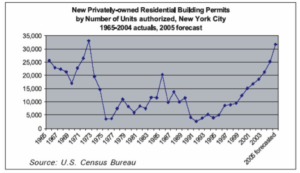Deed and Mortgage Searches
In many jurisdictions, finding historical information on a specific site can be a challenge. To streamline the search process in New York City, the Department of Finance created an online system called ACRIS, which is an acronym for Automated City Register System. ACRIS can be used to search property records on any property located in Manhattan, Queens, the Bronx and Brooklyn. Information regarding properties located on Staten Island must be obtained through the office of the Richmond County Clerk. For convenience, they also have an online search tool that can be accessed via the Richmond County Clerk’s website: www.richmondcountyclerk.com. The public can use the online tool to search property records free of charge by creating a username and password.
For properties located in Manhattan, Queens, the Bronx and Brooklyn, ACRIS can be accessed by pasting the following link into your web browser: http://a836‐acris.nyc.gov/CP/. There are a number of different ways to search for records via ACRIS. Users can search using the party name, property address, parcel information (borough, block, lot) or document ID number (CRFN for documents recorded on or after January 2, 2003). Any public document that was recorded or filed with the City Register will appear in the search results. Such documents include: deeds, mortgages, satisfactions of mortgages, personal property documents, Uniform Commercial Code (UCC) financing statements and Notices of Federal Tax Liens (FTL). However, only documents filed after January 1, 1966 are available online using the ACRIS tool. To access documents filed before January 1, 1966 you must visit the City Register Business Office in the borough where the document was originally recorded or filed. Information regarding offices in each borough can be found below.
Borough City Register Offices:
Manhattan City Register Office
66 John Street, 13th Floor New York, NY 10038
Mon ‐ Fri: 8:30 AM to 4:30 PM
Bronx City Register Office
3030 Third Avenue, Room 280
Bronx, NY 10455
Mon ‐ Fri: 9 AM to 4:30 PM
Brooklyn City Register Office
210 Joralemon Street, 2nd Floor Brooklyn, NY 11201
Mon ‐ Fri: 9 AM to 4:30 PM
Queens City Register Office
144‐06 94 Avenue
Jamaica, NY 11435
Mon ‐ Fri: 9 AM to 4:30 PM
As mentioned above, an ACRIS search will reveal any mortgages currently or previously encumbering a property. Users can access images of documents that were recorded in connection with a mortgage loan. Depending on the document, users should be able to extract information regarding the borrower, lender and certain terms of the loan. It should be noted that there is often a period of time between when a document is recorded and when it appears on ACRIS. Users should be aware of this and can check back periodically until the document appears. ACRIS can also be a useful tool for tracing chain of title, which will be covered in the next section.
Title Searches
A title search is a way to determine who owns real property and the bundle of rights that are associated with it. An examination of the public record will reveal who the owner of a property is along with anyone that may have an interest in it by means of such instruments as easements or liens. To ensure that a thorough title search is conducted many property owners and mortgage lenders will retain a title company. As a student, it might not be feasible to retain a third party to conduct research for you. Instead you can conduct your own search applying the same techniques as a title company.
The first step in a title search is to determine the history of ownership. In New York City the best way to do this is by visiting the applicable Borough City Register Offices listed above and reviewing the public records. Students can request copies of conveyances of title such as deeds, assignments or contracts of sale. If the property in question was built more recently (after 1966) an online search can be conducted using ACRIS. From the available documents, a chronological “chain of title” can be constructed, which should show any exchanges of ownership from the time the property was first established. If there are any gaps in the chain of title, meaning there is no clear documentation indicating how ownership went from one party to another, a title insurance company may need to be retained to further investigate or provide insurance in the case of a sale or financing. A gap in title could be a simple clerical error or it could be a more serious ownership issue. The second step in reviewing title is to determine the status of real estate taxes against a property. Notices of Federal Tax Liens can be found using the ACRIS search tool. Unpaid taxes or special assessments will also appear in a tax search and should be noted for their priority lien status. The various ways to obtain information on property taxes in New York City are discussed in detail in the following section.
The third step performed by title companies is referred to in the industry as the “Report on Possession.” A title company will often send an inspector to a site to verify various physical attributes and identify any potential easements that did not appear on record. Unrecorded easements that are visible should be noted as they could affect the owner’s title and consequently the value of the property. If feasible and permissible by law, it is recommended that students also visit their sites to conduct a walk around inspection. The final step in the title search process is to conduct a judgement and name search. Title companies want to find out if there are any unsatisfied liens against a previous or current owner of the property. This is especially important when a property is being considered for a sale or financing. Judgements against previous owners, unpaid federal income taxes and/or mechanic’s liens can all be cause for concern as they can subordinate a lender or purchaser’s rights. To conduct a background search, lawyers and title companies will often retain a legal research provider such as LexisNexis or Financial Risk Mitigation (“FRM”). Searches should be conducted for any individual or entity that has a significant interest in the borrowing entity or owner of a property. Types of searches should include: UCC, bankruptcy, litigation, judgements, tax likens, media searches, anti‐money laundering watch lists and credit searches. Judgement and name searches will likely be beyond the scope of work required of a student at Baruch. It is however, useful to be familiar with them, as it is a component of title research that is frequently used in real estate lending.
Tax Treatment
There are a number of ways to collect information on property taxes in New York City. A good place to start is with the Digital Tax Map, which is maintained by the Digital Tax Map Office at the Department of Finance (the “DOF”). Best if used in Internet Explorer, the map can be accessed through the following link: http://maps.nyc.gov/taxmap/. The website currently contains three interactive maps. Users can search (i) the Current Tax Map, (ii) the Library of Tax Maps (since May 2008) or (iii) the History of Tax Map Changes (since May 2008). The website also contains a fourth option, titled “Historical Alteration Books”, where users can search a digital library of records regarding tax map changes made by the DOF Tax Map Unit prior to May 2008. The interactive maps can be particularly helpful in gathering information regarding lot lines, block and lot numbers, lot dimensions, and easements. If an address or block/lot number is not currently known, users can simply zoom into the area of interest to gather such data. Once you have determined the precise address or block and lot numbers, you can enter this information into the search bar to find out more detailed building and property data. Depending on the property type such information could include: year built, number of floors, gross floor area, total number of units, land use, zoning district, etc.
For information regarding property tax bills the Department of Finance also has an online tool. The direct link is:
http://nycprop.nyc.gov/nycproperty/nynav/jsp/selectbbl.jsp.
Once on the site, users can search using a property’s borough, block and lot number or a property’s address. Quarterly Statements, Notices of Property Value and Market Value history are listed as public information. Users can view Notices of Property Value throughout the
history of a property. Such notices provide information on a property’s “Market Value” and “Assessed Value”. It is important to note that the values the DOF assigns as “Market Values” often have very little correlation to what the actual market price of a property is. This can be attributed to the fact that the DOF calculates “Market Value” for condominium and co‐operative buildings as if they were rental apartment buildings. State law requires assessors to use income and expense statements from what are deemed to be similar rental buildings to determine value. The resulting values can differ quite significantly from what is seen in the market. It is therefore recommended that students do not use “Market Values” from DOF tax forms as an accurate estimate of property value. Students should refer to the section on Comparable Properties for more information on researching property values. The “Assessed Value”, on the other hand, can be a useful tool, as the DOF uses this value to calculate a property’s taxes.
Information regarding property tax benefits in New York City is also made available to the public. The public can view property exemptions and abatements by accessing the following link:
https://a836-propertyportal.nyc.gov/ and entering the BBL number or address. The property portal currently displays information regarding the following personal exemption benefit programs: Basic and Enhanced STAR, Senior Citizen Homeowner, Disabled Homeowner, Veteran, and Clergy, as well as information on the following commercial exemption programs: 421a, 421b, 421g, ICIP, J51, DAMP, UDAAP, and Not‐For‐Profit. Additionally, the following tax abatements will appear in a search via the portal: J51, 421g, CEP/CRP, Solar Electric Generating System, Green Roof, and Condo/Coop. If a particular property is currently receiving one of the above exemptions or abatements, the portal will indicate the type of benefit, benefit amount, benefit start and end date, current year and calculation method. Government‐related financing, tax abatements and rental subsidy programs are discussed further in Section II C of this report.



